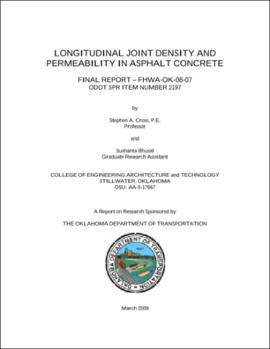| dc.creator | Cross, Stephen | |
| dc.creator | Bhusal, Sushanta | |
| dc.date.accessioned | 2018-04-20T22:47:28Z | |
| dc.date.available | 2018-04-20T22:47:28Z | |
| dc.date.issued | 2009-3 | |
| dc.identifier.govdoc | FHWA-OK-08-07 | |
| dc.identifier.other | Oklahoma Department of Transportation State Planning and Research item number 2197 | |
| dc.identifier.uri | https://hdl.handle.net/11244/299500 | |
| dc.description.abstract | Low longitudinal joint density has been identified as one of the major issues relating to poor asphalt pavement performance. Low longitudinal joint density can lead to premature raveling of the joint and the lower density results in increased permeability of the pavement. Increased permeability allows water to easily enter the pavement resulting in increased susceptibility to moisture induced damage or stripping. The Oklahoma Department of Transportation (ODOT) does not currently have a test method or specification that addresses the problem of low longitudinal joint density. The objective of this study was to obtain the necessary field and laboratory test data to provide information around which a test method and/or specification for control of longitudinal joint density could be written. Three recently constructed pavements were selected for field testing. One pavement was on a county road and the other two pavements were ODOT construction projects. Two or three locations from each project were sampled and tested for a total of seven test sites. Field testing at each site consisted of measuring inplace permeability, measuring pavement density using an electromagnetic device (OHD L-14 Alternate Method B) and obtaining pavement cores at five locations at each test site. Field permeameters used included an NCAT permeameter, a Kentucky air induced permeameter (AIP) and a Romus air permeameter. Laboratory permeability (OHD L-44) was determined on pavement cores. The results from pavement density testing, core density testing, field permeability testing and laboratory permeability testing were analyzed to determine relationships between field permeability, pavement density and laboratory permeability. The suitability of using field permeability at longitudinal joints for control of longitudinal joint density and permeability was evaluated. | |
| dc.format.extent | 54 pages | |
| dc.format.extent | 949,000 bytes | |
| dc.format.medium | application.pdf | |
| dc.language | en_US | |
| dc.relation.ispartofseries | No | |
| dc.relation.requires | Adobe Acrobat Reader | |
| dc.relation.uri | http://www.okladot.state.ok.us/hqdiv/p-r-div/spr-rip/library/reports/fhwa-ok0807.pdf | |
| dc.title | Longitudinal Joint Density and Permeability in Asphalt Concrete (FHWA-OK-08-07 2197) | |
| dc.type | Technical Report | |
| dc.description.version | Final Report, November 2006-December 2008 | |
| dc.description.peerreview | No | |
| dc.type.material | text | |
| dc.subject.keywords | Permeability | |
| dc.subject.keywords | pavement density | |
| dc.subject.keywords | NCAT permeameter | |
| dc.subject.keywords | AIP | |
| dc.subject.keywords | Romus permeameter | |
| dc.contributor.sponsor | Oklahoma Department of Transportation. Materials and Research Division. Office of Research & Implementation | |
